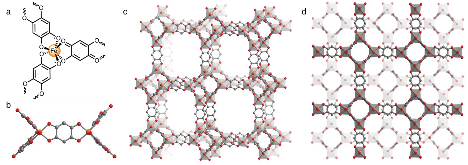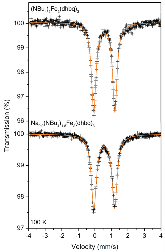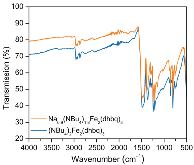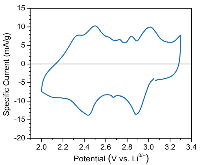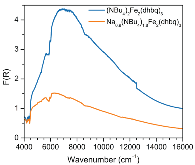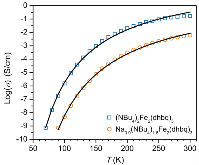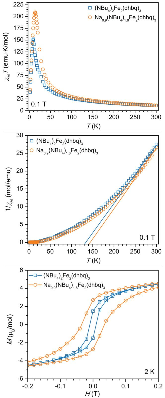|
Isoreticular Expansion of Metal–Organic Frameworks with Triangular and Square Building Units and the Lowest Calculated Density for Porous Crystals
|
journal
|
September 2011 |
|
Metal–Organic Framework Materials with Ultrahigh Surface Areas: Is the Sky the Limit?
|
journal
|
August 2012 |
|
The Chemistry and Applications of Metal-Organic Frameworks
|
journal
|
August 2013 |
|
Systematic Design of Pore Size and Functionality in Isoreticular MOFs and Their Application in Methane Storage
|
journal
|
January 2002 |
|
Metal–Organic Framework Materials as Chemical Sensors
|
journal
|
September 2011 |
|
Carbon Dioxide Capture in Metal–Organic Frameworks
|
journal
|
September 2011 |
|
Metal–Organic Frameworks (MOFs)
|
journal
|
January 2014 |
|
Engineering Metal Organic Frameworks for Heterogeneous Catalysis
|
journal
|
August 2010 |
|
Towards Conducting Metal-Organic Frameworks
|
journal
|
January 2011 |
|
Metal organic frameworks for electrochemical applications
|
journal
|
January 2012 |
|
Thin Film Thermoelectric Metal-Organic Framework with High Seebeck Coefficient and Low Thermal Conductivity
|
journal
|
April 2015 |
|
Magnetic metal–organic frameworks
|
journal
|
January 2009 |
|
Microporous magnets
|
journal
|
January 2011 |
|
Dynamic magnetic MOFs
|
journal
|
January 2013 |
|
Electrical conductive coordination polymers
|
journal
|
January 2012 |
|
Electroconductive Porous Coordination Polymer Cu[Cu(pdt) 2 ] Composed of Donor and Acceptor Building Units
|
journal
|
October 2009 |
|
Conductivity, Doping, and Redox Chemistry of a Microporous Dithiolene-Based Metal−Organic Framework
|
journal
|
July 2010 |
|
Porous, Conductive Metal-Triazolates and Their Structural Elucidation by the Charge-Flipping Method
|
journal
|
June 2012 |
|
High Charge Mobility in a Tetrathiafulvalene-Based Microporous Metal–Organic Framework
|
journal
|
July 2012 |
|
Mn 2 (2,5-disulfhydrylbenzene-1,4-dicarboxylate): A Microporous Metal–Organic Framework with Infinite (−Mn–S−) ∞ Chains and High Intrinsic Charge Mobility
|
journal
|
May 2013 |
|
Tunable Electrical Conductivity in Metal-Organic Framework Thin-Film Devices
|
journal
|
December 2013 |
|
Million-Fold Electrical Conductivity Enhancement in Fe 2 (DEBDC) versus Mn 2 (DEBDC) (E = S, O)
|
journal
|
May 2015 |
|
Cation-Dependent Intrinsic Electrical Conductivity in Isostructural Tetrathiafulvalene-Based Microporous Metal–Organic Frameworks
|
journal
|
January 2015 |
|
New Porous Crystals of Extended Metal-Catecholates
|
journal
|
August 2012 |
|
π-Conjugated Nickel Bis(dithiolene) Complex Nanosheet
|
journal
|
February 2013 |
|
Redox Control and High Conductivity of Nickel Bis(dithiolene) Complex π-Nanosheet: A Potential Organic Two-Dimensional Topological Insulator
|
journal
|
October 2014 |
|
High Electrical Conductivity in Ni 3 (2,3,6,7,10,11-hexaiminotriphenylene) 2 , a Semiconducting Metal–Organic Graphene Analogue
|
journal
|
April 2014 |
|
Cu 3 (hexaiminotriphenylene) 2 : An Electrically Conductive 2D Metal-Organic Framework for Chemiresistive Sensing
|
journal
|
February 2015 |
|
A two-dimensional π–d conjugated coordination polymer with extremely high electrical conductivity and ambipolar transport behaviour
|
journal
|
June 2015 |
|
Conductive metal–organic frameworks and networks: fact or fantasy?
|
journal
|
January 2012 |
|
Coordination compounds of 1,4-dihydroxybenzoquinone and its homologues. Structures and properties
|
journal
|
January 2002 |
|
Spin Exchange Effects on the Physicochemical Properties of Tetraoxolene-Bridged Bimetallic Complexes
|
journal
|
April 2007 |
|
Magnetic exchange interactions in transition metal dimers. 11. Structural and magnetic characterization of [Ni2(tren)2(C6O4Cl2)](BPh4)2 and [Cu2(Me5dien)2(C6O4Cl2)](BPh4)2. Magnetic exchange interactions propagated by the dianions of 2,5-dihydroxy-1,4-benzoquinones
|
journal
|
September 1977 |
|
Tetraoxolene radical stabilization by the interaction with transition-metal ions
|
journal
|
June 1991 |
|
A Dinuclear Ruthenium(II) Complex with the Dianion of 2,5-Dihydroxy-1,4-benzoquinone as Bridging Ligand. Redox, Spectroscopic, and Mixed-Valence Properties
|
journal
|
January 1996 |
|
Characterization of the Chloranilate(•3−) π Radical as a Strong Spin-Coupling Bridging Ligand
|
journal
|
August 2006 |
|
Synthesis, Structure, and Magnetic Properties of Valence Ambiguous Dinuclear Antiferromagnetically Coupled Cobalt and Ferromagnetically Coupled Iron Complexes Containing the Chloranilate(2−) and the Significantly Stronger Coupling Chloranilate(•3−) Radical Trianion
|
journal
|
February 2007 |
|
A dinuclear iron( ii ) complex, [(TPyA)Fe II (THBQ 2– )Fe II (TPyA)](BF 4 ) 2 [TPyA = tris(2-pyridylmethyl)amine; THBQ 2– = 2,3,5,6-tetrahydroxy-1,4-benzoquinonate] exhibiting both spin crossover with hysteresis and ferromagnetic exchange
|
journal
|
January 2008 |
|
Observation of Redox-Induced Electron Transfer and Spin Crossover for Dinuclear Cobalt and Iron Complexes with the 2,5-Di- tert -butyl-3,6-dihydroxy-1,4-benzoquinonate Bridging Ligand
|
journal
|
May 2009 |
|
Straightforward Synthesis of Substituted p -Quinones: Isolation of a Key Intermediate and Use as a Bridging Ligand in a Diruthenium Complex
|
journal
|
March 2010 |
|
Coordination Polymers of 2,5-Dihydroxybenzoquinone and Chloranilic Acid with the (10,3)- a Topology
|
journal
|
July 2011 |
|
2D and 3D Anilato-Based Heterometallic M(I)M(III) Lattices: The Missing Link
|
journal
|
May 2015 |
|
A Novel Hybrid Supramolecular Network Assembled from Perfect ??? Stacking of an Anionic Inorganic Layer and a Cationic Hydronium-Ion-Mediated Organic Layer
|
journal
|
November 2004 |
|
A Family of Layered Chiral Porous Magnets Exhibiting Tunable Ordering Temperatures
|
journal
|
August 2013 |
|
Synthesis, magnetic susceptibility, and Moessbauer spectra of iron(III) dimers and iron(II) polymers containing 2,5-dihydroxy-1,4-benzoquinones
|
journal
|
February 1979 |
|
Synthesis, magnetic susceptibility, and spectroscopic properties of single- and mixed-valence iron oxalate, squarate, and dihydroxybenzoquinone coordination polymers
|
journal
|
October 1979 |
|
Novel Intercalation Host System Based on Transition Metal (Fe 2+ , Co 2+ , Mn 2+ )−Chloranilate Coordination Polymers. Single Crystal Structures and Properties
|
journal
|
December 1998 |
|
Design of metal-complex magnets. Syntheses and magnetic properties of mixed-metal assemblies {NBu4[MCr(ox)3]}x (NBu4+ = tetra(n-butyl)ammonium ion; ox2- = oxalate ion; M = Mn2+, Fe2+, Co2+, Ni2+, Cu2+, Zn2+)
|
journal
|
August 1992 |
|
A Concept for the Synthesis of 3-Dimensional Homo- and Bimetallic Oxalate-Bridged Networks [M2(ox)3]n. Structural, Moessbauer, and Magnetic Studies in the Field of Molecular-Based Magnets
|
journal
|
October 1994 |
|
Oxalate-Based 3D Chiral Magnets: The Series [ZII(bpy)3][ClO4][MIIFeIII(ox)3] (ZII = Fe, Ru; MII = Mn, Fe; bpy = 2,2'-Bipyridine; ox = Oxalate Dianion)
|
journal
|
June 2005 |
|
Increasing the Ordering Temperatures in Oxalate-Based 3D Chiral Magnets: the Series [Ir(ppy) 2 (bpy)][M II M III (ox) 3 ]·0.5H 2 O (M II M III = MnCr, FeCr, CoCr, NiCr, ZnCr, MnFe, FeFe); bpy = 2,2‘-Bipyridine; ppy = 2-Phenylpyridine; ox = Oxalate Dianion)
|
journal
|
July 2006 |
|
Preparation of a semiquinonate-bridged diiron(ii) complex and elucidation of its geometric and electronic structures
|
journal
|
January 2013 |
|
Structural and magnetic properties of tris(o-semiquinone) complexes of iron(III) and chromium(III)
|
journal
|
December 1978 |
|
Mixed-Valence Li/Fe-Based Metal–Organic Frameworks with Both Reversible Redox and Sorption Properties
|
journal
|
April 2007 |
|
Synthesis, Structure, Characterization, and Redox Properties of the Porous MIL-68(Fe) Solid
|
journal
|
July 2010 |
|
Monitoring the Solid-State Electrochemistry of Cu(2,7-AQDC) (AQDC = Anthraquinone Dicarboxylate) in a Lithium Battery: Coexistence of Metal and Ligand Redox Activities in a Metal–Organic Framework
|
journal
|
November 2014 |
|
MIL-101(Fe) as a lithium-ion battery electrode material: a relaxation and intercalation mechanism during lithium insertion
|
journal
|
January 2015 |
|
New Route to the Mixed Valence Semiquinone-Catecholate Based Mononuclear Fe III and Catecholate Based Dinuclear Mn III Complexes: First Experimental Evidence of Valence Tautomerism in an Iron Complex
|
journal
|
September 2004 |
|
The Localized-to-Delocalized Transition in Mixed-Valence Chemistry
|
journal
|
September 2001 |
|
Intervalence Charge Transfer (IVCT) in Trinuclear and Tetranuclear Complexes of Iron, Ruthenium, and Osmium
|
journal
|
June 2006 |
|
Current trends and future challenges in the experimental, theoretical and computational analysis of intervalence charge transfer (IVCT) transitions
|
journal
|
January 2006 |
|
Organic Mixed Valence
|
journal
|
August 2011 |
|
Reduction of a Metal-Organic Framework by an Organometallic Complex: Magnetic Properties and Structure of the Inclusion Compound [(η5-C5H5)2Co]0.5@MIL-47(V)
|
journal
|
July 2010 |
|
Voltammetric reduction and re-oxidation of solid coordination polymers of dihydroxybenzoquinone
|
journal
|
January 2012 |
|
Metal–Organic Framework Thin Films Composed of Free-Standing Acicular Nanorods Exhibiting Reversible Electrochromism
|
journal
|
December 2013 |
|
Facile Deposition of Multicolored Electrochromic Metal-Organic Framework Thin Films
|
journal
|
October 2013 |
|
Ligand Redox Non-innocence in the Stoichiometric Oxidation of Mn 2 (2,5-dioxidoterephthalate) (Mn-MOF-74)
|
journal
|
February 2014 |
|
Controlling charge separation in a novel donor–acceptor metal–organic framework via redox modulation
|
journal
|
January 2014 |
|
Magnetically ordered molecule-based materials
|
journal
|
January 2011 |
|
A Room-Temperature Molecular/Organic-Based Magnet
|
journal
|
June 1991 |
|
Crystal Structure and Physical Properties of Conducting Molecular Antiferromagnets with a Halogen-Substituted Donor: (EDO-TTFBr 2 ) 2 FeX 4 (X = Cl, Br)
|
journal
|
April 2007 |
|
Glassy Magnets Composed of Metals Coordinated to 7,7,8,8-tetracyanoquinodimethane: M(TCNQ) 2 (M = Mn, Fe, Co, Ni) †
|
journal
|
May 2003 |
|
Ferrimagnetic Mixed-Valency and Mixed-Metal Tris(oxalato)iron(III) Compounds: Synthesis, Structure, and Magnetism
|
journal
|
January 1996 |
|
Molecules to build solids: high TC molecule-based magnets by design and recent revival of cyano complexes chemistry
|
journal
|
September 1999 |
|
The disodium salt of 2,5-dihydroxy-1,4-benzoquinone as anode material for rechargeable sodium ion batteries
|
journal
|
January 2015 |
|
Calculating Geometric Surface Areas as a Characterization Tool for Metal−Organic Frameworks
|
journal
|
October 2007 |
|
Magnetic Molecular Conductors
|
journal
|
November 2004 |

